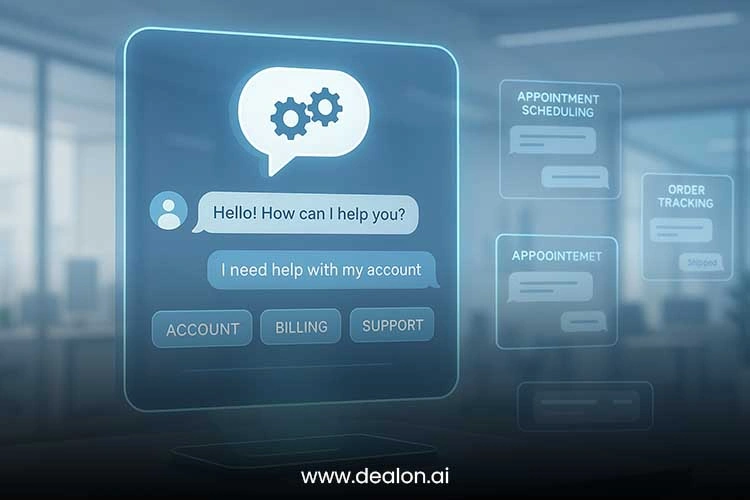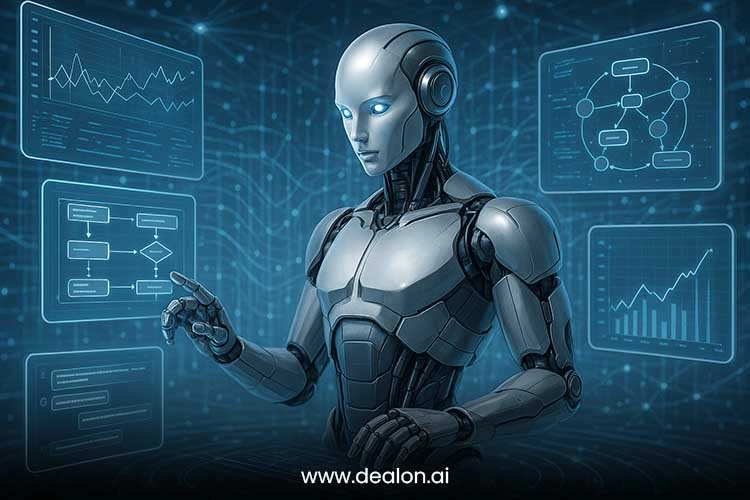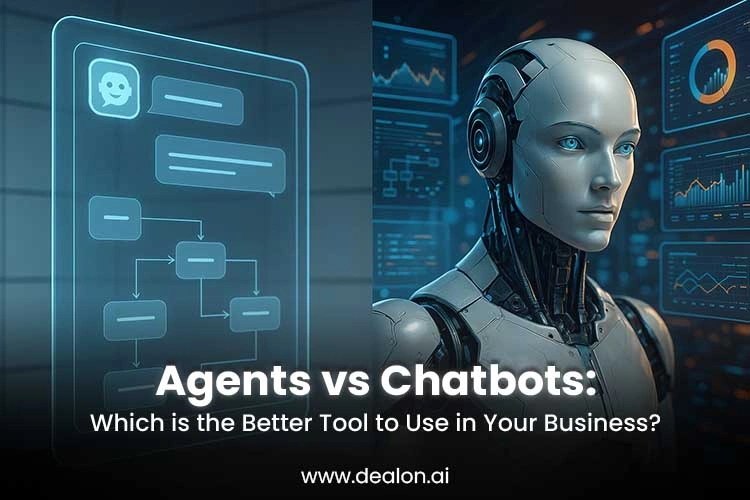The expectations of customers have changed drastically in the current hyperconnected economy. The necessity to deliver immediate, intelligent, and very personalized interactions is putting pressure on businesses to offer conversational technologies in any digital strategy. Of these technologies, two terms prevail in the discussion: the AI agents and chatbots. Though the terminology is more often than not tossed around carelessly, these systems are on the whole vary widely in terms of their capacity, flexibility, and value addition.
Chatbots became the initial version of conversational interfaces, programming them to do simple rule-based tasks. They have well-thought-out scripts and intermediate structured workflows, performing well under repetitive and routine-based service situations. The limitations of this group are, however, pronounced when divergent conversations have to be provided, which require the employment of a subtle line of reasoning or an adaptable problem-solving approach.
In comparison, AI agents show an evolutionary step change in intelligence and situational awareness. By building on the ability to understand human language well, combined with machine learning and agentic AI, these systems do not simply react, but can also perceive, plan, and act. They can integrate with business programs, perform analysis on streaming data, and offer the best decisions to resolve multi-step, complicated cases without too much human monitoring. This will enable them to stop being reactive tools and become proactive digital collaborators that can redefine operations, whether they are customer support or workflow orchestrators.
Also Read: OpenAI vs Anthropic: Which AI Models are Leading the AI Race in 2025?
Chatbots: Programmed Text Chats and Rule-Engined Automation

Chatbots are the first form of conversational interface, and it is designed to imitate simple conversations by using a set of predetermined rules. These systems operate in a manner that is like a decision tree in that each action by the user causes a reaction. They are not very smart, but they have made an impact on the improvement of customer service and the efficiency of the business.
Conventional chatbots are based on a set of predefined patterns. When a user posts an interaction, the chatbot searches for keywords or compares the request to a template that has been set up. Tapping responses are then derived by use of a stored knowledge bank. It is a menu-driven interaction model that is predictable and therefore suits an environment where queries are easier and repetitive, e.g., What are your business hours? Or, how do I reset my password?
The best part of the chatbots is that they are simple and not expensive. They can be implemented quickly by businesses without having to use massive datasets or complicated machine learning algorithms. When put in place, their presence is accessible 24/7, meaning that the customers will get an immediate response even during off-hours. This capacity to computerize low-fidelity, high-volume requests relieves human agents of those requests and allows them to dedicate their time to the more nuanced and valuable interactions.
The other strength of Hallmark is consistency. They are more uniform compared to a human agent and can be more accurate and consistent with brand terms, with chatbots, because human agents react differently to different questions with varying tones. This consistency is beneficial in industries where publication of compliance documentation or where exact messaging is vital.
FAQ automation, appointment scheduling, simple troubleshooting, and lead qualification are the most significant applications of conventional chatbots. To give an example, an e-commerce chatbot can help a customer navigate through the returns policy, provide them with the tracking of their orders, or recommend a product using minimal input.
These strengths are, at the same time, the weaknesses of the rule-based way of chatbots. They are not proactive and are, in effect, reactive in their dealings, which makes them unable to deal with scenarios that are outside their expected scenarios. Whenever the flow of conversations is not as expected, how the conversation should go, that is, when questions are ambiguous, multi-layered, or even emotional, chatbots fail to perform satisfactorily, leaving users irritated by irrelevant or repetitive responses. Their contextual ignorance and insensitivities prevent them from being able to deal with many exchanges involving dynamic real-life conversations.
Considering the current pace of change in the business environment, conventional chatbots are best suited to serve as initial screening agents that will smooth out the simple questions and delegate them to human agents or other advanced forms of AI. They are still a crucial part of digital ecosystems as they are reliable and low-cost. Yet, given the tendency for the expectations of the customers to increase, organizations are implementing increasingly more innovative AI agents with ongoing rule-based systems that can reason contextually and act autonomously.
Ultimately, chatbots are the key to automated customer interaction–highly useful where it is desirable to achieve simpler, more widespread customer interaction, but by no means a complete end in itself as far as organizations committed to providing individualizing, responsive, and highly involving customer experience are concerned.
AIs: Self-Governing, Context-Based Problem Solvers

AI agents are a leap towards the new level of creating conversational systems that go beyond the constraints of scripted systems by providing contextual reasoning, learning, and autonomous decisions. In contrast to chatbots, which can only respond to queries in a reactive and rule-based manner, AI agents are much more like digital co-workers who are capable of not only comprehending complex questions but also modifying their behavior to adapt to a user and going through a series of actions without any explicit guidance.
Machine learning models, natural language understanding, and agentic AI architectures are the fuel for AI agents. These systems are created to assist in massive amounts of data in real-time, developing meaning-of-intent through subtle language, and making contextual understanding encompass the whole discussion instead of a single message. This context memory enables them to free-flow and have that flowing human conversation, creating fluid responses generated by the previous conversational interaction.
Autonomy is one of the capabilities that AI takes to be an agent. They do not just act in response to commands but may take the initiative to make things happen to achieve their goals. This way, in the process of service request management, an AI agent can gather appropriate data, access databases and retrieve documents, book an appointment, and inform participants as a whole workflow process would undergo without human interaction. These systems can even interact with other agents and organize themselves into self-organizing networks that coordinate across departments or even platforms.
The other main strength is that of adaptability. AI agents take experience and learn through interactions, improve decision-making throughout their lives, and change their behavior to respond to new data. This enables them to work efficiently in dynamic environments, where circumstances change regularly, making them irreplaceable in the areas of finance, logistics, the healthcare sector, and research.
The use of AI agents is much broader than straightforward customer experiences. They are implemented in customer support tailored to individual needs, sophisticated workflow automation, mathematical information analysis, and an intelligent research assistant. As an example, an AI agent within a law firm may be able to read a set of legal documentation, make out applicable precedent cases, create a summary, and display the conclusions to an attorney, but doing so entirely without prompting or need to choose among any alternatives.
The potential to incorporate with enterprise software and external information sources makes AI agents complete end-to-end solutions as opposed to conversational agents. Such an intense level of interaction helps businesses to attain operational efficiency, better decision-making, and a personalized experience at scale.
Although AI agents need more investment in terms of infrastructure and data to maintain, the benefits that are associated with them lie in the promise of consistent, scalable, and proactive intelligence generation. They become strategic assets rather than just tools, and they transform the way organizations can manage the process of digital transformation. The benefits of AI agents bring a paradigm change to static automation toward dynamic intelligence. They represent the new era of machine-driven collaboration: not just responsive systems, they think, act, and learn, and propose an insight into the new era of business automation and customer interaction.
Which One Will Fit Your Business?

The key question to ask is whether it is the right choice to engage with a chatbot or an AI agent in your organization, and this depends on strategy and not technology. The purpose that both tools serve is to streamline operations and get customer engagement, but they are miles apart in terms of their capabilities, and these discrepancies affect the overall usage in your digital ecosystem.
Traditional chatbots are a good fit for companies that value efficiency and cost-effectiveness in serving high volumes of repetitive, structured steps in their flow of interaction. These systems work well where the set of questions can be defined and is relatively small and predictable, and where the questions are easily associated with a predefined workflow. Such retail businesses as those that use chatbots to respond to their most common questions, connect clients to information about their orders, and walk them through simple return policies. Chatbots can handle outstanding round-the-clock availability because the predicted speed and invariance help to minimize the number of human agents that a conversation needs to assist customers.
Nevertheless, with the changing nature of customer expectations toward individually tailored and context-aware experiences, the showdowns of the rule-based chatbots are becoming more visible. AI agents assist businesses that involve large amounts of data by being able to process information independently, support the latter by making recommendations, and predict needs. They are much more than surface-level automation, touching enterprise systems with live data analysis and setting up multi-step workflows entirely without human involvement.
In any industry that deals with people (financial services, healthcare, or B2B technology) and any situation where we can take advantage of specific situations that clients are in because in the moment, the value of the decision is absolute, AI agents perform well in building rapport, continuing the conversation, and ensuring the dynamic interaction creates value. The coming of hybrid models signifies the fact that not every organization should decide between one and the other anymore.
They instead launch conversational ecosystems with multiple layers: A chatbot can be used as the initial-level triage agent, which can address straightforward questions immediately, passing more multifaceted or subtle requests to AI agents that can think more deeply. This architecture enables scale without sacrificing sophistication or being able to personalize experiences, which can drive competitive advantage. Ultimately, it is the business goals, data environment, and the targeted customer experience that should inform such a decision. Chatbots are still a viable option when it comes to businesses that are seeking to automate normal processes at the lowest possible cost.
Organizations that are willing to instill intelligence in the core of their operations can benefit through flexibility, control, and competitiveness brought forth by AI agents. Forward-thinking leaders are tending toward mixed strategies as they realize that these are not mutually exclusive. Decisions on how best to use these tools together, or how they complement each other, could spell the difference between the success with which your business assimilates the needs of a coming generation of customer interfacing and operational automation.
Conclusion
The emergence of conversational technologies is a seminal change in the business understanding of their clientele through the management of workflows and the communication procedures followed. Chatbots and AI agents represent two stages in this evolution. Chatbots are simple, scalable, and predictable in terms of automation, and thus, are best suited for handling structured and repetitive tasks effectively. Compared to them, artificial agents provide contextual knowledge, flexibility, and independence, enabling organizations to tackle complicated challenges and act on complex workflows with multiple steps, and provide consumers with personalized, data-driven practice.
The choice between these two technologies should not be based on which is a superior technology, but rather on how well each meets your strategic intentions, customer expectations, and the environment in which your data operates. Chatbots are an excellent idea with low investment because businesses dealing with stable, predictable companies can use the chatbots without any problems. The possibility of going beyond casual interactions has become a reality because AI agents provide an opportunity to envision a new realm of automations and decision-making.
These days, it is becoming more common to see competitors that are a combination of chatbots and AI agents, with chatbots being used to handle routine transactions due to their efficiency and AI agents being used to handle transactions relating to high-value transactions. This stratified model can be fast and smart enough so that technology becomes responsive to business intricacy. The beauty of it all is that the level of responsiveness and personalization is a key to success, and this means that the optimal combination of the tools will be chosen.

